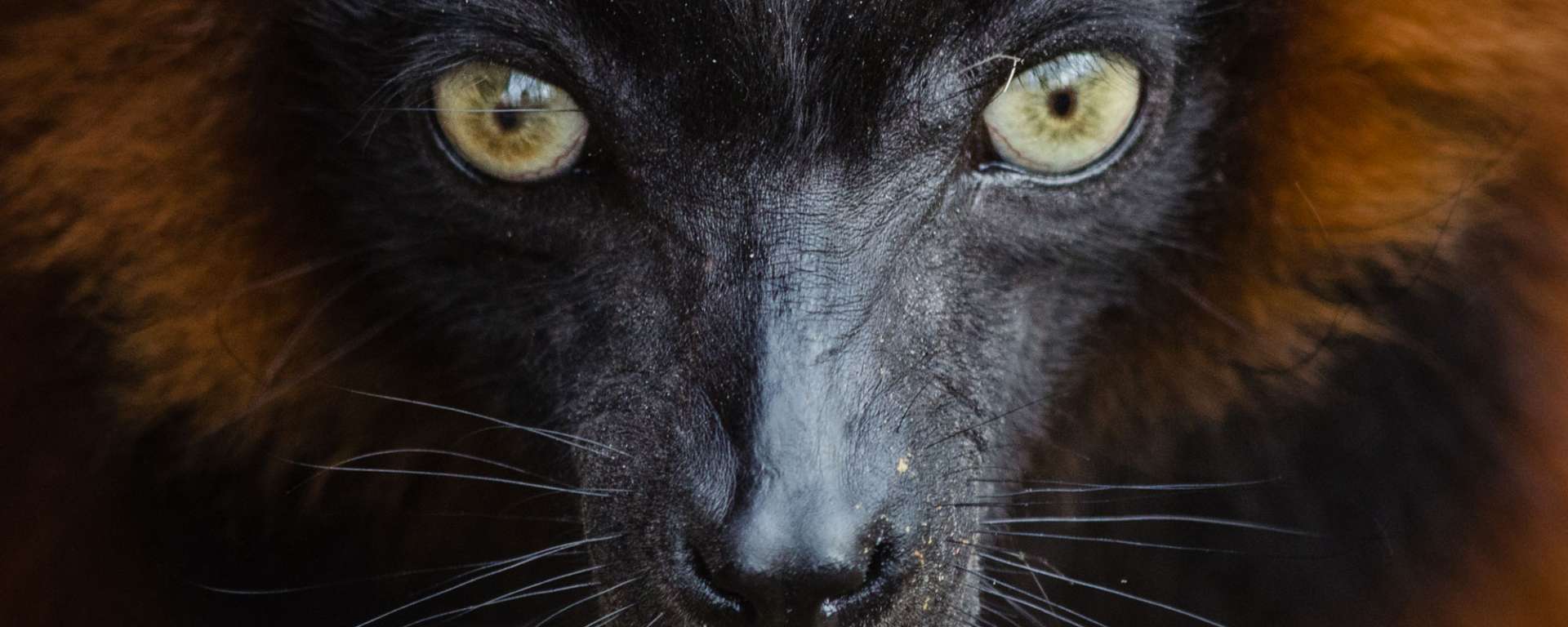Safari Spotlight: The Red Ruffed Lemur
Posted in: Safari Spotlight
Tags: Red Ruffed Lemur
The Latest Lemurs to Land at Safari West!
Safari West has long been the proud home of two lemur species: the famous and easily identified ring-tailed lemur, and the more obscure and much rarer black-and-white ruffed lemur. It is with great excitement that we now announce the latest prosimian species to find a home here: the red ruffed lemur!
Never heard of the red ruffed lemur? Not to worry, most people haven’t. These incredibly rare and unusual animals are far from common and haven’t enjoyed the same degree of exposure that their ring-tailed cousins have. That said, if you’re familiar with the appearance of the ring-tailed lemur, a red ruffed specimen would look at least a little familiar. The species share features such as long fox-like faces, big eyes, and luxuriously long tails. A major difference, however, comes in the form of coloration. The red-ruffed lemur is a burnt chestnut colored animal with a striking black face, tail, and limbs. They are also surprisingly fluffy; a characteristic that serves them well in the often damp and chilly environment of their rainforest homes.
Red Ruffed Lemurs are Incredibly Rare
Another reason why you may not be familiar with the red ruffed lemur is that they are extremely rare, both in the wild and in captivity. While all lemur species share a degree of vulnerability due to their restriction to the island of Madagascar, the red ruffed lemur is restricted to an even smaller range. Found only on the Masoala peninsula on the north-east coast of Madagascar, all the wild red ruffed lemurs in the world live in an area half the size of the Hawaiian island of Maui. This tiny range suffers from aggressive illegal logging which shrinks the remaining habitat every day. Alongside this relentless threat are wildfires, frequent cyclones, and human hunting pressures. Taken together, these factors have led to a precipitous decline in red ruffed lemur numbers. While we don’t have a firm grasp on how many are left, their population is less than 20% of what it was only a quarter-century ago.
Luckily, red ruffed species are on the conservation radar. Breeding programs are up and running at several AZA (Association of Zoos and Aquariums) facilities and there is a Species Survival Plan (SSP) in place. An SSP is a program designed and implemented by the network of biologists, behavioral specialists, and animal care staff working in the broader zoological community. It exists to help improve breeding practices and survival strategies for a species as a whole. When properly enacted, SSPs allow us to develop sustainable human-managed populations of a species as a reserve population in case the wild population should go extinct.
In the case of the red ruffed lemur, this remains a distinct possibility. While a national park has been created inside their remaining geographic range, the stability of that park and indeed, of the government that created it, remains tenuous.
Come Say Hello!
While we work with other members of the AZA to conserve this unique species, we also invite you to come meet our red ruffed lemurs and learn more about them. Like their black-and-white ruffed cousins, these are among the loudest of all primate species and in all likelihood, your visit will be interrupted by the raucous calling of one or both species. You’ll also bear witness to their amazing acrobatics as these tree-dwelling primates scamper and bound around their habitats.
As you view our red ruffed and black-and-white ruffed lemurs, keep in mind that you are looking at some of the only nest-building primates in the world. Both species have short gestation periods which leads to infants born without the ability to cling to their mothers the way young monkeys frequently do. Both species use nests to protect and contain their helpless offspring until they reach a more capable level of development. With the red ruffed lemur, this typically takes only a few weeks and afterward mother lemur will begin “parking” her infants in a convenient tree as she goes about foraging.
Foraging for what, you may ask? As it turns out, the red ruffed lemur is among the most frugivorous of primates. They love fruit! They are most active mid-morning, as the sun is still climbing toward its zenith and can usually be found high in the most mature trees searching out ripe fruits, delicious flowers, and even pollen to satisfy their appetites. One common acrobatic display seen from these lemurs is a hanging handstand. Gripping the thin and flexible upper branches with their hind feet, they’ll dangle and stretch, reaching for the delectable fruit below.
Come visit Safari West and say hello to our newest residents as they settle into their new home. Witness their acrobatics and enjoy their cacophonous vocalizations. These rare and beautiful creatures are sure to amaze. Join us at Safari West and play your part in helping to conserve the incredible and incredibly rare red ruffed lemur!


